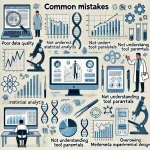The development of drugs based on the 3-dimensional molecular structure of a particular target.
Reading frame
A sequence of codons beginning with an intiation codon and ending with a termination codon, typically of at least 150 bases (50
amino acids) coding for a polypeptide or
protein chain (see ORF and URF).
Reagents
Sources of biological or chemical material that can be used as the starting blocks in laboratory experiments. Reagents can range from chemicals needed to perform a particular chemical reaction, constituents of a laboratory protocol, or clones to be used in a large-scale
gene expression study.
Recessive
Any trait that is expressed phenotypically only when present on both alleles of a
gene (cf dominant).
DNA molecules resulting from the fusion of DNA from different sources. The technology employed for splicing DNA from different sources and for amplifying the resultant heterogenous DNA.
Recombination
A new combination of alleles resulting from the rearrangement occuring by crossing-over or by independent assortment (see crossing over).
Recursion
An algorithmic procedure whereby an algorithm calls on itself to perform a calculation until the result exceeds a threshold, in which case the algorithm exits. Recursion is a powerful procedure with which to process data and is computationally quite efficient.
Regulatory gene
A
DNA sequence that functions to control the expression of other
genes by producing a protein that modulates the synthesis of their products (typically by binding to the gene promoter). (cf. Structural gene).
A database that follows E. F. Codd’s 11 rules, a series of mathematical and logical steps for the organization and systemization of data into a
software system that allows easy retrieval, updating, and expansion. An RDBMS stores data in a database consisting of one or more tables of rows and columns. The rows correspond to a record (tuple); the columns correspond to attributes (fields) in the record. In an RDBMS, a view, defined as a subset of the database that is the result of the evaluation of a query, is a table. RDBMSs use Structured Query Language (
SQL) for data definition,
data management, and data access and retrieval. Relational and object-relational
databases are used extensively in bioinformatics to store sequence and other
biological data.
A software system that includes a database architecture, query language, and data loading and updating
tools and other ancillary software that together allow the creation of a relational database application.
Repeats (repeat sequences)
Repeat sequences and approximate repeats occur throughout the DNA of higher organisms (mammals). For example, the
Alu sequences of length about 300 characters, appear hundreds of thousands of times in Human DNA with about 87% homology to a consensus
Alu string. Some short substrings such as TATA-boxes, poly-A and (TG)* also appear more often than by chance. Repeat sequences may also occur within genes, as
mutations or alterations to those genes. Repetitive sequences, especially mobile elements, have many
applications in genetic
research. DNA transposons and retroposons are routinely used for insertional mutagenesis, gene mapping, gene tagging, and gene transfer in several model systems.
Repetitive elements
Repetitive elements provide important clues about chromosome dynamics, evolutionary forces, and
mechanisms for exchange of
genetic information between organisms The most ubiquitous class of repetitive elements in the DNA sequence in primate genomes is the
Alu family of interspersed repeats which have arisen in the last 65 million years of evolution
Alu repeats belong to a class of sequences defined as short interspersed elements (SINEs). Approximately 500,000
Alu SINEs exist within the human
genome, representing about 5% of the genome by mass.
Replication
The synthesis of an informationally identical macromolecule (e.g. DNA) from a template molecule.
Repressor
The protein product of a regulatory gene that combines with a specific operator (regulatory DNA sequence) and hence blocks the
transcription of genes in an operon.
Restriction enzyme (restriction endonuclease)
A type of enzyme that recognizes specific
DNA sequences (usually palindromic sequences 4, 6, 8 or 16 base pairs in length) and produces cuts on both strands of DNA containing those sequences only. The “molecular scissors” of rDNA technology.
Variation within the DNA sequences of organisms of a given species that can be identified by fragmenting the sequences using restriction enzymes, since the variation lies within the restriction site. RFLPs can be used to measure the diversity of a gene in a population.
Restriction map
A physical map or depiction of a gene (or genome) derived by ordering overlapping restriction fragments produced by digestion of the DNA with a number of restriction enzymes.
The use of protein information to elucidate the genetic sequence encoding that protein. Used to describe the process of gene isolation starting with a panel of afflicted patients (see positional cloning) .
Reverse transcriptase
A DNA polymerase that can synthesise a complementary DNA (cDNA) strand using
RNA as a template – a so-called RNA-dependent DNA polymerase.
Reverse transcriptase-PCR (RT-PCR)
Procedure in which
PCR amplification is carried out on DNA that is first generated by the conversion of mRNA to cDNA using reverse transcriptase.
Ribonucleic acid (RNA)
A category of nucleic acids in which the component sugar is ribose and consisting of the four nucleotides Thymidine, Uracil, Guanine, and Adenine. The three types of RNA are messenger RNA (mRNA), transfer RNA (tRNA) and ribosomal RNA (rRNA).
Raw sequence
Sequence that has been neither finished nor curated, and therefore not ready for annotation.
Regulatory elements
DNA sequences that control expression of a gene by binding to proteins that increase or decrease synthesis of the gene product.
RepeatMasker
A program that screens DNA sequences for interspersed repeats and low complexity DNA sequences.
Repetitive DNA sequence
A DNA sequence that is repeated multiple times in the genome; such sequences can vary considerably in length and number of copies per genome.
Replication
The process of producing two DNA molecules from one. During replication, the two strands of the parent helix separate and DNA polymerase synthesizes a new, complementary strand for each parental strand, following the rules of base pairing (A-T and G-C).
Retrotransposon
These are transposable DNA elements (transposons) that employ retroviral-like reverse transcription during the process of transposition: retrotransposon DNA is first transcribed into an RNA template which is then reverse-transcribed into a DNA copy that is inserted into a new genomic site.
Reverse strand
In a display of a double-stranded DNA sequence, which may be as long as an entire chromosome, the strand that is read from 5′ to 3′ from left to right is called the forward or plus strand. The strand that is read from 5′ to 3′ from right to left is called the reverse or minus stand.
RNA
Ribonucleic acid. A nucleic acid that is the primary product of gene expression. Chemically, it differs from DNA by the substitution of ribose for deoxyribose in the sugar-phosphate backbone and by the substitution of the base uracil for thymine.
RNA polymerase
An enzyme that synthesizes a strand of RNA by adding successive ribonucleotides in the order dictated by a template strand of DNA.
















